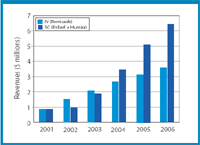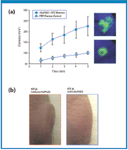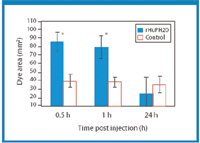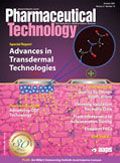Converting Intravenous Dosing to Subcutaneous Dosing With Recombinant Human Hyaluronidase
The preferred route of administration for an injected therapeutic agent is subcutaneous (SC), but SC injections are generally limited to no more than 1-2 mL in volume, representing a major challenge, especially for large protein biologics.
Although subcutaneous (SC) delivery is the preferred way to administer an injected therapeutic, SC injections are limited in the amount of drug substance that can be delivered. Strategies for overcoming this problem are crucial to widening the scope of drugs that may be given subcutaneously. Using a recombinant DNA-derived hyaluronidase enzyme is an approach for possibly changing dosing regimens and bioavailability of several types of agents, including biologics.
Intravenous, intramuscular, and subcutaneous delivery
Intravenous administration. Therapeutic agents can be introduced into the body by several routes of administration with each having specific advantages and disadvantages (see Table I). For many drugs, including biologics and anticancer agents, the traditional route of administration is intravenous (IV). IV injections are given either as a 1-to-2-min-bolus or an infusion with a longer duration to facilitate administering precise doses in a controlled manner or in providing a rapid response. IV dosing is also typical when administering irritating agents such as cytotoxics that would otherwise cause tissue damage and pain if given by alternative routes. IV dosing requires the skilled insertion of a needle or catheter directly into a vein, a process that can be challenging, especially in certain patient types such as obese, palliative-care, and neonate patients. Direct IV access also carries a risk of systemic infection. IV drugs are administered by trained medical personnel in a hospital or physician's office and, because of the rapid effects achieved, patients are typically observed for undesired side effects following injection. This entire process occupies both space in an office and specialized nursing time (1).
Intramuscular injections. When therapeutic regimens require injection volumes in excess of 1 mL, intramuscular (IM) injections are generally chosen. IM injections are given deep into skeletal muscle and usually involve the gluteal, deltoid, rectus femoris, or vastus lateralis muscles. Volumes of 2–5 mL can be administered, and this route is particularly suited for drugs that are not readily soluble, as a sustained depot action is possible (2, 3). Because of the distance from the skin surface into a muscle, IM injections require a relatively long needle (1–2 in.). There is a possibility of hitting a nerve or blood vessel, leading to muscle contractures and nerve injury (3). Because of the needle length and bore size required, IM injections are painful and can temporarily result in limited mobility, an issue of particular concern in older patients (2). IM injections, therefore, are best performed by trained personnel who are familiar with anatomical landmarks, which may be difficult to identify in obese or emaciated patients. Infection is a risk with any parenteral injection because of the risk of bacteria being introduced into the tissue (2, 4–6), which in turn can lead to abscesses and infections in the skin or soft tissue. Other complications of IM injections include local induration, erythema, hematoma, persistent bleeding, and ultimately, drug discontinuation. Less common side effects can include intramuscular hemorrhage, cellulitis, tissue necrosis, and gangrene (7, 8). Although several studies have shown that there are no substantial differences between IM and SC injections in terms of absorption and drug efficacy (2), the absorption rate from an IM injection does depend on blood flow at the injection site and the muscle mass. Also, the rate may be unpredictable in infants because of insufficient muscle tone and vascularity of muscle tissue.
Subcutaneous delivery. During SC administration, a needle is inserted through the epidermal and dermal layers of the skin and into the fatty subcutaneous tissue. Following injection, the drug reaches the bloodstream via the capillaries or the lymphatic system, depending on the molecular size of the therapeutic (2, 3, 9). Large proteins are typically not suited for oral administration, as such drugs would be degraded in the digestive tract and poorly absorbed. Most proteins require SC administration. Large-molecule drugs typically reach the bloodstream through the lymphatic vessels as they move very slowly from the tissues into the capillaries.
SC injections have several immediate advantages over other injection types. In contrast to the skilled personnel required for the administration of IV and IM injections, SC injections can be administered by the patient (2, 3). A small needle is required (length of ⅜–⅝ in.), and the injections are not generally painful and carry a reduced risk of infection and other complications. If an infectious agent is injected subcutaneously, it is generally limited to a local infection rather than a systemic infection. For patients requiring multiple doses, SC injections offer a broader range of alternative sites (3). The resultant drug absorption is also slower than IV and may avoid the risks of bolus administration.
From many perspectives, including reduced pain, improved patient quality of life, reduced cost of patient care, and reduced risk of infection, SC represents a preferred route for administering a drug by self-injection. Many drugs, including insulin and heparin, have been delivered subcutaneously for many years with excellent outcomes. In a recent survey by Lash Group Healthcare Consultants of oncology practices across the country, there is a conscious shift to SC administration (1). Compared with IV drugs, the majority of participants in the survey considered SC drugs clinically safer and more cost-effective, resulting in higher patient satisfaction.
Subcutanous versus intravenous. It can be enlightening to compare the actual administration costs of a drug that can be delivered by both IV and SC routes. Campath (alemtuzumab) is a recombinant humanized monoclonal antibody directed against CD52 for treating B-cell chronic lymphocytic leukemia in patients who have been treated with alkylating agents and who have failed fludarabine therapy (10). The drug is delivered by IV and SC routes. The cost of supplies required for IV administration are substantially more than those required for SC administration (1). The staffing requirements for IV administration (2–6 h of observation) are higher than those of SC injections (0.5–1 h). Also, the associated costs are not captured in the reimbursed allowables and represent a hidden cost.
The anti-TNF-alpha treatments for rheumatoid arthritis and Crohn's disease are also good examples of the relative desirability of SC versus IV administration. Centocor's Remicade (infliximab) is an antibody that is administered intravenously, and Amgen's Enbrel (etanercept) and Abbott Laboratories' Humira (adalimumab) are both given subcutaneously. Efficacy differences between all three drugs when administered with methotrexate are considered minimal (11). A broad indicator, such as revenues (see Figure 1) shows that IV- and SC-delivered agents were essentially equal in 2001, and both have been growing at healthy rates. The relative growth rate of the SC agent, however, is approximately 50% higher than that of the IV drug (a 33% compound annual growth rate for IV versus 50% for SC), translating into 2006 revenues for the SC agent that are almost double that of the IV agent. This increase occurred despite reimbursement dynamics for SC injectables that were unfavorable until recently (12).

Figure 1: Revenues of intravenous (IV)- versus subcutaneous (SC)-administered anti-TNF-alpha treatments (2001â2006). (FIGURES: HALOZYME THERAPEUTICS)
Limitations in subcutanous administration. Given the advantages of SC administration, the question can be asked: Why are there are not more SC injectable protein agents on the market? This situation may be attributed to several well-known disadvantages associated with SC injections (see Table I). One disadvantage is that SC injections are generally limited to no more than 1–2 mL (3). Several ways to circumvent these volume limitations, including increasing the concentration of the active ingredient in the formulation, have been pursued. For proteins, resultant issues of viscosity, solubility, and protein aggregation become major obstacles, especially with small-gauge needles that are typically preferred by the patient. For agents of limited solubility such as monoclonal antibodies, large volumes must be injected via frequent, small-volume injections. Additionally, at the injection site, some drugs are trapped and locally degraded, leading to lowered bioavailability, and others can be retained at high concentrations, which sometimes leads to concentration-dependent adverse reactions or reduced bioavailability. These issues are challenging problems for converting IV- and IM-dosing to SC regimens.

Table I: Intravenous, intramuscular, and subcutaneous injections: advantages and disadvantages.
At the heart of the volume limitations of SC injections are collagen and hyaluronan, two major components of the subcutaneous interstitial matrix.
The extracellular matrix
The extracellular matrix (ECM) serves to control the diffusion and bulk-fluid flow of molecules while maintaining specific tissue architecture. Within the hypodermis, the ECM is composed of a structural network of fibrous proteins embedded within a hydrated viscoelastic gel (see Figure 2). The fibrous network is composed of structural building blocks such as collagen and elastin that support adipocytes and vascular structures. This solid network is embedded within a viscoelastic gel composed of glycosaminoglycans (GAGs) that creates a barrier to bulk-fluid flow because of their viscosity and water of hydration (13). GAGs are complex linear polysaccharides characterized by repeating disaccharide structures of an N-substituted hexosamine and an uronic acid, including hyaluronan (hyaluronic acid or HA), chondroitin sulfate, dermatan sulfate, heparin sulfate, heparin and keratin sulfate. All (except HA) exist covalently bound to core proteins.

Figure 2. Model of enzyme-mediated delivery through the interstitial matrix. Degradation of glycosaminoglycans (gold) by hyaluronidase (blue) promotes flow of drug molecules (magenta) through the interstitium. Collagen fibrils (grey/white) are not modified and retain the architecture of the skin. (FIGURES: HALOZYME THERAPEUTICS)
Together, collagen and HA create a volume barrier for local injections of no more than 2 mL, as the tissue distortion that occurs with larger volumes is painful and often leads to reduced patient compliance for repeat-injection drugs (14). In addition, the collagen matrix can trap certain drugs allowing them to be locally degraded, and the viscosity of the ECM can cause large proteins to be retained, leading to injection- site reactions and lowered bioavailability. Despite the obvious advantages of SC administration and the ongoing trend to convert IV and IM drugs to SC regimens, the barriers imposed by the ECM significantly reduce the feasibility of developing new therapies with SC dosing.
Hyaluronidase: a strategy for overcoming ECM's limits
Transiently degrading key components of the ECM may lower the dispersion and volume barriers of the ECM and permit the conversion of many IV and IM drugs to SC administration (15). Collagen, however, has a half-life of almost 15 years and its removal would likely lead to permanent tissue structural changes and damage (16). Modifying HA is a far more attractive target for drug delivery, as HA has a half-life of 15–20 h (17).
The clinical development of a drug-delivery system mediated by a hyaluronidase can be traced back to the discovery in 1928 of a "spreading factor" in extracts of animal testes that facilitated the dispersion of co-injected materials (18–20). Based on its ability to digest HA in vitro, the spreading activity in the extracts was defined as a hyaluronidase (21). It became clear that nature had used a HA-degrading enzyme as a delivery agent to increase the dispersion of venoms, toxins, sperm, and bacteria through the ECM (22). To use this enzyme as a drug-delivery tool, fractionated extracts containing hyaluronidase from bovine testes were developed as pharmaceutical products. The first such product, Wyeth's Wydase, was approved in 1948, followed by Searle's Alidase in 1949, and Abbott Laboratories' Hyazyme in 1951. At one point, 10 hyaluronidase-containing compounds (with approved new drug applications) were legally on the market in the United States. The active protein in these crude preparations that was responsible for the hyaluronidase activity was never actually identified. As a result of the animal origin (bovine) and lack of purity (<1%), several safety issues limited the chronic use of these agents. These crude preparations can be contaminated with proteases, immunoglobulins, and other factors that increase capillary permeability and can result in IgE-mediated allergic reactions with repeat administration (23–25). Any pharmaceutical product derived from animal tissue has the potential to be plagued with a shortage of raw materials, subsequent manufacturing and supply problems, and the real risk of transmission of viruses and other contaminants (e.g., spongiform encephalopathies such as mad cow disease).
Not surprisingly, numerous attempts were made to purify the hyaluronidase to homogeneity from testicular extracts. Unfortunately, attempts to increase the specific activity from chromatographically fractionated preparations merely served to show that the enzyme was present in only trace amounts in the original marketed preparations (26, 27). Such commercial preparations, with specific activity of approximately 750 units/mg, could be further purified with decreased yield to 50,000–100,000 units/mg (28–30).
In time, the structural identity of testicular hyaluronidase was eventually elucidated, albeit through a rather circuitous pathway. The purification to homogeneity of a hyaluronidase from bee venom, and the subsequent amino-acid sequencing and cDNA cloning, revealed significant homology to the cDNA of a recently identified sperm-surface antigen, PH-20 (31, 32). Without any knowledge of its hyaluronidase activity, the PH-20 protein had been previously identified as a glycosyl-phosphatidylinositol (GPI) lipid-anchored antigen on the plasma membrane of sperm. Within this work, expression of PH-20 in rabbit kidney cells showed the hyaluronidase activity associated with the membrane. Biochemical purification and molecular studies have identified a family of hyaluronidase-like genes in the human genome (33). PH-20, however, is the predominant hyaluronidase in mammalian testes, and among the hyaluronidase-like genes, only the PH-20 enzyme is active at neutral pH that degrades GAGs under physiologic conditions. The human enzyme is a 509-amino acid glycoprotein anchored to the plasma membrane through a GPI moiety (34).
An rDNA-derived human PH-20 hyaluronidase enzyme
Hyaluronidase enzymes from testes had been commercially used as "spreading factors" for more than 50 years despite drawbacks and inadequacies. The discovery of the human PH20 gene and its identification as a hyaluronidase, however, unlocked the potential of producing a reliable recombinant human hyaluronidase enzyme.
Molecular engineering and manufacturing. To develop a human PH-20 hyaluronidase, several issues had to be overcome, including the specific identification of the membrane anchor and controversy over whether the soluble human protein retained enzymatic activity at physiologic pH (35, 36).Previous attempts to produce the 382-amino acid bee venom enzyme in bacterial host systems showed only weak activity. Because the human PH20 contained eight additional cysteine residues (12 total) with multiple N-linked glycosylation sites, expression in mammalian systems were considered for deletion mutagenesis (32). Earlier studies showed that deletion mutagenesis of the carboxy terminus of the PH-20 gene near the proposed GPI anchor site or truncated further to the equivalent carboxy terminus of the bee-venom hyaluronidase failed to produce an active enzyme in mammalian cells (35). Therefore, a series of deletion mutants of the PH-20 cDNA were produced containing HIS6 epitope tags at the carboxyl terminus. Soluble hyaluronidase activity was demonstrated in deletion mutants terminating after amino acids 477– 483. In contrast, less than 10% activity was maintained when constructs terminated after amino acid 467 or when using the full-length PH-20 cDNA (37).
The soluble domain of the human PH-20 hyaluronidase cDNA (encoding amino acids 1–482) was cloned into a well-characterized mammalian cell line (Chinese hamster ovary cells) in order to develop a recombinant human hyaluronidase (rHuPH20) for pharmaceutical use. Purified to homogeneity, the rHuPH20 protein is a 61–63 kDa glycosylated enzyme with a specific activity 50–100 fold greater than commercially available animal hyaluronidase extracts (on a unit/mg protein basis) (38). rHuPH20 exists as a homogeneous preparation, in contrast to the multiple impurities in the commercial bovine-derived material. Indeed, only one minor 75 kDa band in the smear of protein cross-reacted strongly with the anti-ram PH-20 monoclonal antibody, confirming that the hyaluronidase enzyme is a minor component of animal-derived extracts, consistent with the low specific activity.
Comparison with bovine-derived material
It was important to compare the spreading activity of rHuPH20 to the original bovine preparations. It was possible that any of the biologically active contaminants in the animal-derived material (including known contaminants such as proteinases, anticoagulants, growth factors, vasopermeability factors, and immunoglobulins) could potentially contribute to the spreading activity (39–43). These non-hyaluronidase impurities, however, did not contribute significantly. The spreading activity from 5 units of rHuPH20 (100,000 USP units/mg protein) was indistinguishable from that of 5 units of a crude commercial bovine hyaluronidase preparation (approximately 700 units/mg protein) on a unit-per-unit basis when calibrated against the HA substrate in vitro.
Dispersion of co-injected drugs
The intradermal injection of rHuPH20 with high molecular weight fluorescein isothiocyanate-labeled dextran (2 million Da) resulted in a significantly increased dispersion area (Figure 3a). This effect was observed with nanogram amounts of the enzyme (44). Importantly, rHuPH20 injection sites were uniformly dispersed without swelling, in contrast to the significant tissue distortion in control areas in which saline alone had been infused (Figure 3b). As with HA, the principal substrate for rHuPH20 displays a short half-life in comparison to other ECM molecules such as collagen. The dispersion effects should be temporary, provided rHuPH20 is catabolized in a short period of time. As shown in Figure 4, the dispersion of tracer dye had returned to control levels 24 h post-injection (44).

Figure 3: The effect of rHuPH20 on spreading and tissue distortion from injection. (a) rHuPH20 (10 U) or carrier control was co-injected in 50 μL with fluorescein isothiocyanate (FITC)-labeled dextran (2 million Da) in mice and imaged under ultraviolet light. Area of the tracer was measured with microcalipers at 1-min intervals. (b) Reduction of tissue distortion following injection of rHuPH20. Saline containing rHuPH20 or carrier control was infused through a 27-gauge needle with a controlled infusion pump (300 μL/min) for 2 min in both sites. Images were taken at completion of the infusion (time 5 2 min). (FIGURES: HALOZYME THERAPEUTICS)
The possibility existed that the enzymatic degradation of HA with rHuPH20 would produce a variety of breakdown products that could induce inflammatory mediators. This situation would limit the chronic repeat use of rHuPH20, a situation comparable with that of the bovine-derived enzyme preparation. Studies have shown that rHuPH20 does not increase vascular permeability and does not elicit any inflammatory responses in cultures of human microvascular endothelial cells or following SC injection in primates (38).

Figure 4: Evaluation of the duration of the rHuPH20 dispersing effect. Fluorescent-dye dispersion following pretreatment with rHuPH20 or placebo at various times (0.5, 1, and 24 h), * p (p value)

Drug Solutions Podcast: Applying Appropriate Analytics to Drug Development
March 26th 2024In this episode of the Drug Solutions Podcast, Jan Bekker, Vice President of Business Development, Commercial and Technical Operations at BioCina, discusses the latest analytical tools and their applications in the drug development market.